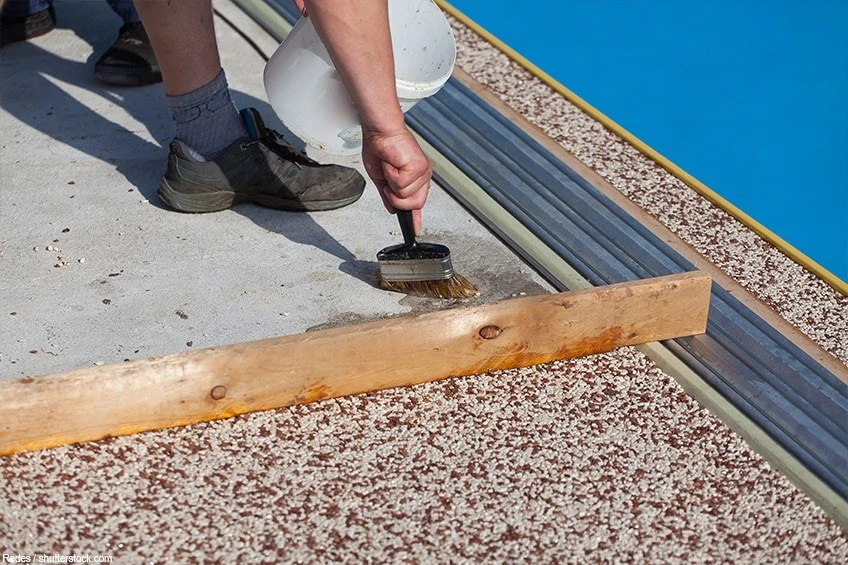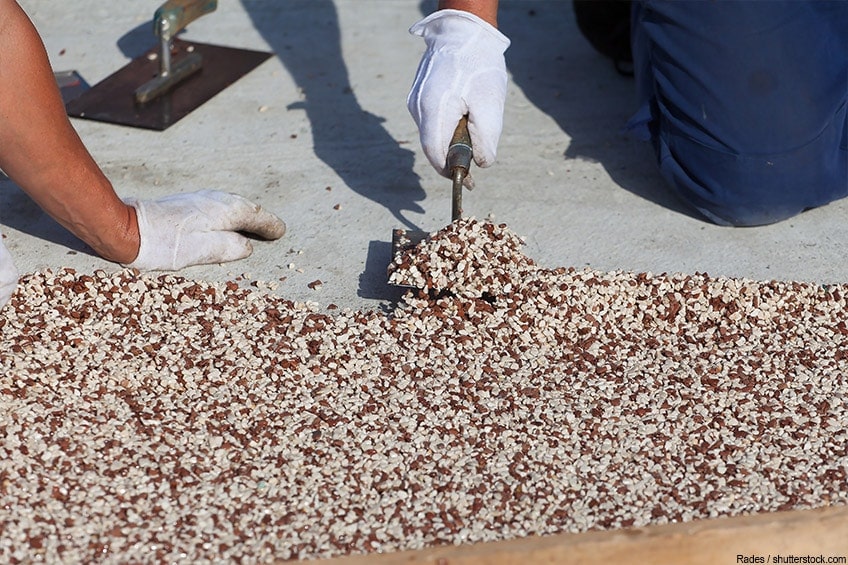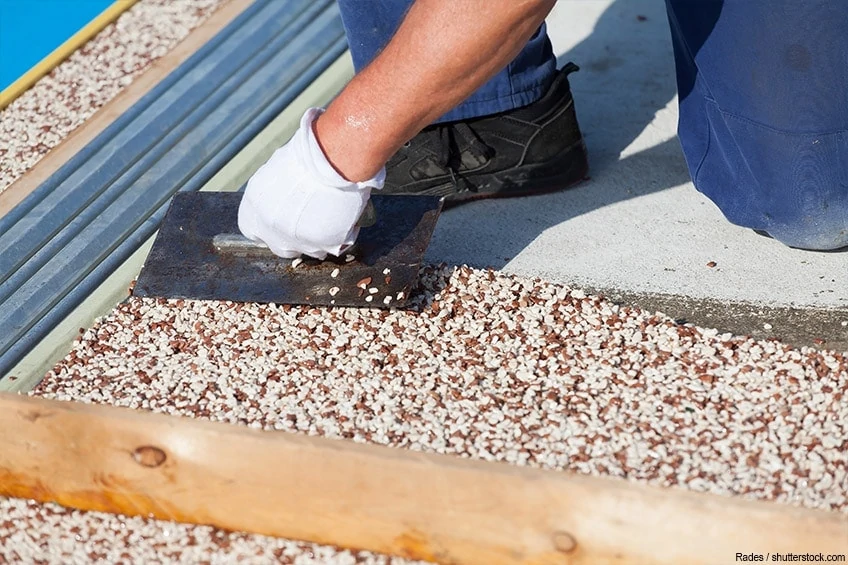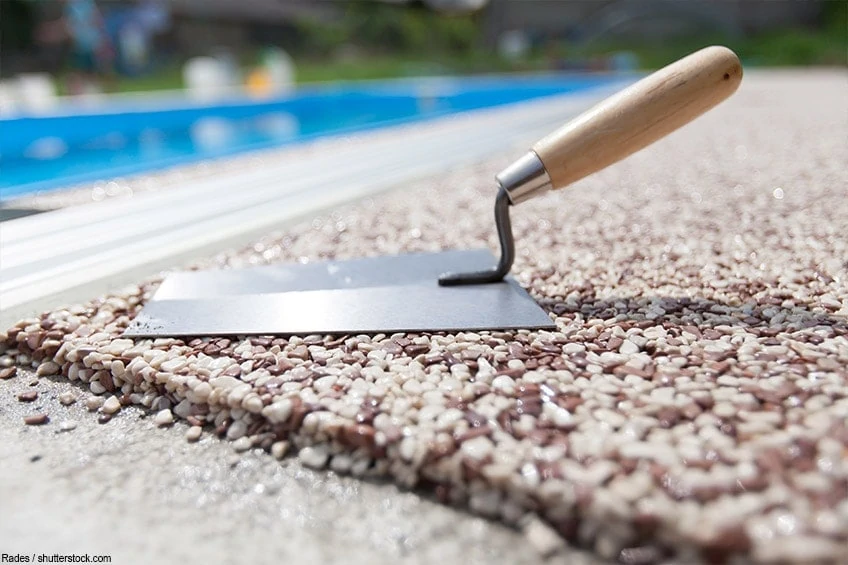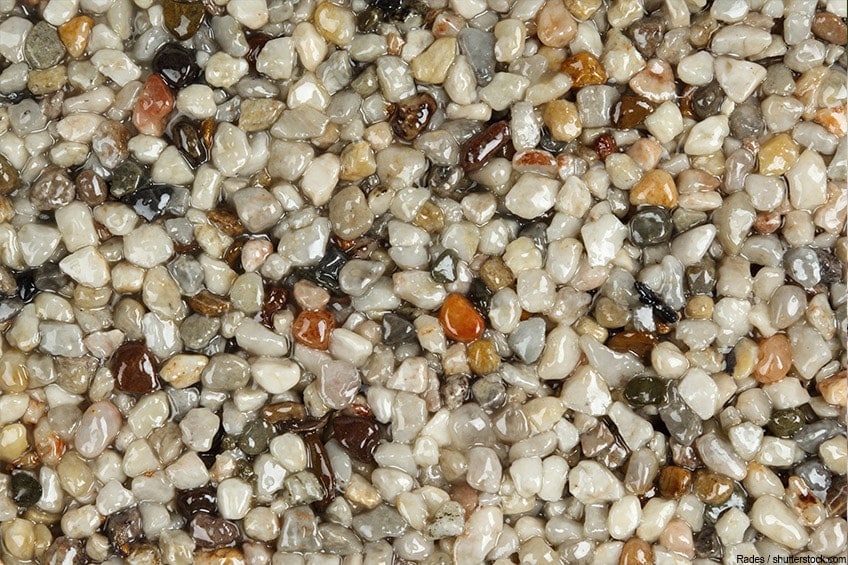Laying a Stone Carpet – Epoxy Stone Floor Guide and Instructions
This post may contain affiliate links. We may earn a small commission from purchases made through them, at no additional cost to you. You help to support resin-expert.com
Stone carpets give every room a noble ambiance. But if you are not very familiar with laying floors, you might shy away from installing a stone carpet. It is no more difficult to lay than pouring screed; you can make a stone carpet yourself using relatively simple methods. In our stone carpet guide, we show you how to lay a stone carpet yourself, the advantages and disadvantages of a stone carpet and what you have to pay attention to when caring for your stone carpet.
Table of Contents
Laying an Epoxy Stone Floor Indoors: Our Tutorial
In principle, a stone carpet is not laid, but poured. You have to pay attention to several things, which we explain in detail in our DIY stone carpet guide. If, however, you feel that you are not up to the task, you can always purchase a stone carpet that has already been made. These tiles are fastened together with a flexible mesh backing that allows one to place and adjust the carpet with ease.
Buying a Pre-Made Stone Carpet: MARGO GARDEN PRODUCTS Rain Forest Mixed Stones
This product includes five irregularly-shaped stone tiles, each of which covers a surface area of 5 feet. The organic shape of the tiles makes it easy to place this carpet anywhere you please, and the flexible mesh backing can also be cut and shaped accordingly. Easy to apply and even to remove, you can use this stone carpet for projects located both indoors and outdoors. The varying colors and textures of the natural stones allow for a truly unique aesthetic for your project.
- Suitable for indoor and outdoor uses
- Natural stones vary in color and texture for a unique look
- High-quality natural pebble mosaic tiles
Pros
- High-quality natural stones
- Easy to use
- Can be adusted according to needs
- Unique look
Cons
- Require grout and an optional sealer to be installed (cannot simply be placed down like a normal carpet)
Materials Required for Building a Pebble Carpet
To begin, you will need the main materials for laying your stone carpet:
- Epoxy Primer
- Epoxy resin (or Polyurethane Resin for outdoors)
- Stone mixture
- Fine quartz sand
You will also need the following construction materials in order to execute this project:
- Mixing paddle
- Large bucket for mixing
- Trowel
- Drilling machine
- Spirit level
- Aluminium edge rails
- Big brush
- Finishing trowel
- Spiked epoxy roller (or an ordinary paint roller)
Always pay attention to your personal safety. Gloves and a respiratory mask should be mandatory, because working with epoxy resin and other binders (such as polyurethane) can cause allergic reactions. Your eyes can also be irritated by the vapors produced, so it is recommended that you wear protective goggles. You can ensure your personal safety by using the following:
This list may seem long, but at second glance, you will find that it includes many of the items that every well-assorted DIY enthusiast already has. The other things can be purchased relatively cheaply at most DIY stores and online shops.
It is also worth mentioning that you should store all the materials you need for about 24 hours at a temperature of at least 59 degrees Fahrenheit (15 degrees Celsius), or even better, at room temperature. Stones and resins are easier to process at these temperatures. Moist material must not be used under any circumstances, otherwise the stones will not hold!
Lay out all the necessary materials and prepare the surface by vacuuming it thoroughly. The floor must be completely dust-free and dry. Now, start with the priming.
Priming of the Substrate
It is essential to provide a solid primer, especially with absorbent surfaces. Failure to do so may cause the epoxy resin to seep away, and the pebbles will loosen over time. This will result in unsightly holes and cracks.
First, thoroughly mix the primer, which consists of two components.
Apply the primer with a broad brush all around the edge and in the corners. You will then need to use a paint roller, the size of which should depend on the area to be worked on. For a large room, use a large roller, otherwise priming will become an arduous task.
Afterwards, some fine quartz sand or silica sand is sprinkled on the moist primer so that the following layer has more grip and can be processed more efficiently. Let the primer dry.
Preparation of the Mixture
Now, mix the two-component binder and stir it thoroughly under the pebbles in the masonry bucket. It is essential to ensure the perfect mixing ratio, otherwise the pebbles will come loose after a few years. Follow the manufacturer’s instructions. Only mix as much as you can process within a short time. It is better to make several mixes in a row than one large one. Otherwise, the working time will be too short, and you will tend to hurry up and make mistakes.
How much resin you have to add to the mixture depends on the stones used. If you work with pebbles, you need 7% epoxy resin, whereas quartz usually requires at least 8%. Marble needs the most, because it acts almost like a sponge – it absorbs a large part of the resin, so you need to add at least 10% resin to the mixture.
Application of the Pebble Carpet
Now, you can pour the pebble carpet. Apply the mixture and immediately smooth it down with a trowel. Always use a finishing trowel and a spirit level to make the floor completely level. Check each area quickly for unevenness and level it out with more material. A very bright lamp will help greatly.
The floor should have a thickness of about 6 mm. If you want a higher depth, you must take a longer drying time into account.
If you only want to line a large area with the mass, the application is relatively simple. A little more demanding is the use of patterns, but even here, you do not necessarily have to be a professional if you want to make a stone carpet.
There are prefabricated aluminum rails that can be clicked together, so you simply need to lay the rails on the surface, nail them down, and then fill in the openings with your mixture. Alternatively, you can, of course, create your own stone carpet pattern. Simply lay out corresponding aluminum rails in the desired shape, nail them down and fill them with the stone carpet compound in different colors.
The latter has the advantage in that you are entirely free in your design options. You can guarantee that with this way, you will not have the same stone carpet in the entrance area as every third neighbor in your neighborhood.
Drying
After about 24 hours, the stone carpet is ready to be walked on, and after 48 hours, you can place light furniture on it. The pebble carpet reaches its final hardness after about seven days. Up to this time, cleaning should be avoided.
After drying and before you set up the furniture, you should always apply a pore seal, especially in damp rooms. Use a layer of clear epoxy resin. This material penetrates the pores of the stone carpet and closes them. The surface structure remains almost entirely intact, but the pore closure ensures a much more hygienic cleaning and additional durability.
Stone Carpet Care and Cleaning
Always wait until the stone carpet is wholly hardened before the first cleaning. The cleaning agent used should be free of any solvents. Otherwise, the binder contained in the stone carpet may dissolve, and within a few years, small pebbles will roll through the house.
Special cleaning agents for stone carpets are available on the market. These usually contain essential oils, and thus guarantee an optimal feel-good fragrance. However, they should only be used in very diluted amounts. A few drops in a bucket of lukewarm water are quite sufficient, otherwise the consequences mentioned above may occur.
To be on the safe side, use a mild soap-based cleaner to clean your stone carpet. Also, do not work with hot water, as this could damage the epoxy resin layer. Water with a temperature of up to 104 degrees Fahrenheit (40 degrees Celsius) is ideal. You do not have to wipe with a damp cloth. The stone carpet can be cleaned very wet, unlike parquet flooring, for example, which can swell if treated too wet.
After you have wiped the surface with soapy water, you should wipe it again with clear water, otherwise streaks may appear on the floor. If the water in your area is very calcareous, you should also clean with a soft microfibre cloth to avoid unsightly edges after drying.
From time to time, you can also wax your stone carpet or apply a thin layer of clear epoxy resin. However, this is not absolutely necessary if the stone carpet has not been damaged.
Laying the Epoxy Stone Floor Outside
You can also make your own epoxy stone floor in the outside area. If you want to lay a stone carpet outside, you should pay attention to several things.
Stone carpets with epoxy resin as a binding agent are not suitable for outdoor use, because they are not lightfast and tend to yellow with the years. They are also unsuitable for rooms flooded with light. For such purposes, you should instead use a stone carpet, which is applied with a PU binder.
In outdoor areas, you must ensure that the stone carpet is open-pored on the outside so that it is weatherproof, otherwise accumulated water can lead to frost damage. Before you start laying the stone carpet, you must ensure that the subfloor has a slope of about one percent.
The main advantage of an outdoor stone carpet is that it is easy to level out any unevenness. The leveling of the subfloor is much easier than with wooden planks or tiles.
If you do not want to use large pebbles, a stone carpet with grains of sand might be an alternative for you. The grains usually have a size of 1 to 3 mm and can be processed just as easily as a carpet of pebbles. Just like the pebbles, they are pleasantly round because watercourses have ground them in riverbeds. This type of surface also creates a pleasant foot feeling.
One difficulty in creating an exterior stone carpet is the different coefficients of expansion of the materials used. The coefficient of expansion describes the extent to which materials contract or expand at different temperatures. For this reason, some experts recommend that an outdoor stone carpet should be installed as a floating installation. This means giving it room to expand, so to speak, in order to avoid tension and cracks in the material.
If you want to be on the safe side, you can fall back on prefabricated stone carpet elements, which are now available in specialist shops. In this way, you effectively avoid damage to the material used and can enjoy your floor for a long time.
Creating Stone Carpet Stairs
Especially on stairs, stone carpets cut an outstanding figure because they provide a pleasant foot feeling and, at the same time, the right grip. With a stone carpet staircase, you can easily upgrade old steps.
Special aluminum rails are available for this application. These prevent the applied coating from slipping and, at the same time, facilitate pouring. The fact that the tracks are almost invisible under the stone carpet, but still function as edge protection, is another advantage. You should not go without these rails; otherwise, the stairs become too vulnerable at the edges, and these can be damaged over time.
Tip: If you want to create a stone carpet staircase, you should take care to apply the material really thinly so as not to change the step height too much.
What Is a Stone Carpet?
A stone carpet is a floor covering made of rounded pebbles, marble pebbles, or quartzites, which are differently colored and, therefore, also available in many different shades. In addition, there is a binder, which is usually epoxy resin or polyurethane (PU) resin. Stone carpets are also offered in different grain sizes. The stones are ground round, so that they give a pleasant feeling when walking.
A stone carpet is poured, similar to screed. This can be done on an already existing floor covering such as concrete or tiles. Stone carpets are open-pored and have no joints. Stone carpets for outside and stone carpets for inside are available. In principle, this covering is perfectly suitable for all needs.
Until 2016, solvent-based stone carpets were still available in stores. These are no longer permitted indoors, as they can emit harmful vapors. The stone carpets used today for interiors are considered harmless to your health.
What Are the Advantages and Disadvantages of a Stone Carpet?
Stone carpets have various advantages and disadvantages compared to other floor coverings:
Pros
- Soundproofing properties
- Ease of care
- A pleasant running feeling
- Relatively simple installation (if you consider a few things)
- Extremely high resistance
- Suitable for indoor and outdoor use
- High resistance to thermal and mechanical stress
- Well-suited for allergy sufferers, as very little dust is whirled up by walking on this surface
- Lightfast
- No static charge possible
- Can be laid on different substrates, such as wood, concrete, or tiles
- Joint-free, smooth surface, and thus optical enlargement of the room
- Warm feel on the feet
- Also suitable as stone quilt stairs
- The stone carpet pattern is freely selectable and can be adapted to the needs of the user
Cons
- Higher costs than laminate and most types of parquet
- Installation is not very difficult, but has some small pitfalls
- Removal is only possible with great effort
- Epoxy resin is not lightfast and therefore not suitable for rooms with large windows; here, you have to resort to the more expensive polyurethane
Another point is the fact that stone carpets can be scratched after years of use. But we do not consider this to be a minus point, as firstly, these scratches occur on nearly every floor covering, even on expensive and robust parquet. Secondly, they can be removed relatively easily. See our tips and tricks at the end of the stone carpet guide.
Whether a stone carpet or even a stone staircase is the right choice for you, you decide, of course, yourself. We will help you further with our handy stone carpet guide!
Examples of Use
The laying of a stone carpet is an especially good idea for outdoor areas or the bathroom, because a pebble carpet is not only beautiful to look at, but also hygienic and waterproof. Haptically speaking, it is an entirely different experience when you step out of the shower, and your feet land on a pebble carpet that is warm to the feet instead of on cold tiles. For the shower itself, a stone carpet is also the ideal solution.
A stone carpet is suitable wherever a noble appearance is desired. Not only do café and car dealership owners like to use a stone carpet pattern, but also private individuals who want to lay a stone carpet outside and thereby refine their garden or the surroundings of a pool.
A stone carpet gives every staircase and every corridor a distinctive flair. Also worked in-between tiles, this covering is a real eye-catcher. Thus, beautiful mosaics of stone carpet elements and tiles are created. You are entirely free in your design possibilities with your stone carpet pattern.
Tip: Why not create a kitchen worktop with a stone carpet? The stone look in particular will give your kitchen a modern-yet-elegant look. With its robustness, it even scores points in terms of cleaning and cut resistance.
Stone Carpet Tips and Tricks
- Make sure that you purchase all the required materials from only one company. In this way, you can ensure that the materials are compatible with each other instead of repelling each other or showing undesirable side effects. If you want to use epoxy resin as a binder, also use an epoxy primer if possible.
- Furthermore, you should make sure that all materials used are certified as harmless, otherwise there is a risk to health.
- In wet rooms, especially when the stone carpet is used as a shower tray, it is essential to pay attention to the slope towards the drain, otherwise the water in the respective room will be dammed up and not drain off. Please also note the application over underfloor heating systems. This is usually possible without any problems, but if in doubt, it is better to seek professional advice.
- If you want to remove scratches from the laid stone carpet, certain resins or fillers can be used. It is best to seek advice on this.



